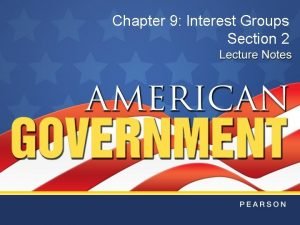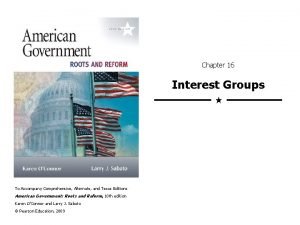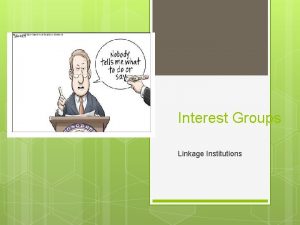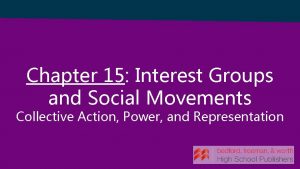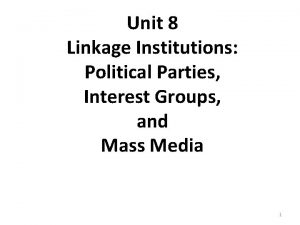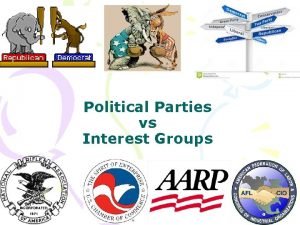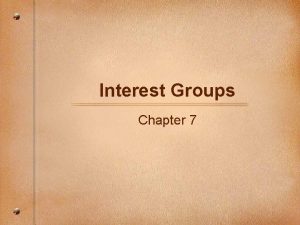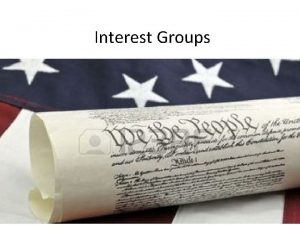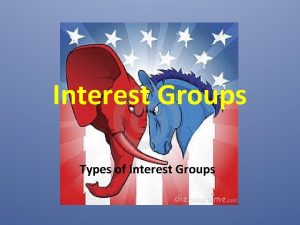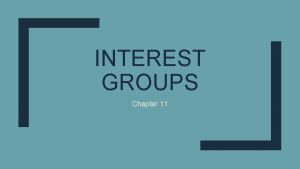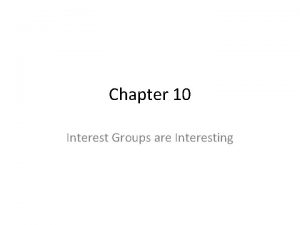Interest Groups Chapter 12 CHAPTER 12 INTEREST GROUPS
















- Slides: 16

Interest Groups Chapter 12 CHAPTER 12: INTEREST GROUPS

In this chapter you will: • What interest groups do in American government—and how they do it • Reflect on whether interest groups wield too much power • Trace the historical roots of interest-group activity, and see how lobbyists have changed • Examine the multiple roles that lobbyists play • Consider whether interest groups are good for America CHAPTER 12: INTEREST GROUPS

Interest-Group Roles in America • Interest groups, or organizations that seek to influence government, employ lobbyists to pursue benefits for their clients or membership. • Groups serve their members by communicating political information to them, analyzing and relating members’ views to policymakers, and mobilizing people to act politically. • A long debate continues among pluralist, hyperpluralist, and power elite theorists about whether the collective public is well represented by interest groups. CHAPTER 12: INTEREST GROUPS

Types of Interest Groups • Interest groups come in several types: Those pursuing primarily economic concerns include business and labor groups, along with trade and professional associations. • Citizen groups include those promoting broad causes (consumer rights, civil liberties) and single-issue advocates such as People for the Ethical Treatment of Animals, as well as ideological groups. • Governments also lobby each other, as well as engaging in “reverse lobbying”—working with interest groups to advance desired aims. CHAPTER 12: INTEREST GROUPS

Interest Groups Past and Present • Interest-group activity in the United States stretches back to the beginning of the republic; our modern system of thousands of active groups dates to the 1960 s-70 s “advocacy explosion. ” • In recent years, younger Americans and women have increasingly populated Washington’s interest-group ranks. CHAPTER 12: INTEREST GROUPS

Interest Group Lobbyists in Action • Lobbyists perform a wide range of roles, from researchers to social butterflies. • Private sector lobbyists can represent a single firm or a trade association, or set up in business for themselves as independent lobbyists. • Citizen groups are often loath to engage in “lobbying, ” but they must to succeed. CHAPTER 12: INTEREST GROUPS

Interest Groups and the Federal Branch of Government • Lobbyists working in specific areas sometimes still form “iron triangles” with congressional staff and executive branch officials. • More fluid “issue networks” featuring lobbyists as central players increasingly characterize today’s complex policymaking environment. CHAPTER 12: INTEREST GROUPS

Interest Groups and the Federal Branch of Government • Successful federal lobbyists master political information gathering and analysis, engage in political campaigns, and form close ties with one of the two major parties. • Interest groups also lobby the judicial branch by funding confirmation battles, filing amicus curiae briefs, and financing litigation. CHAPTER 12: INTEREST GROUPS

Interest Groups and Power • Because of the difficulty of measuring interestgroup influence in government, researchers turn to metrics like number of lobbyists and how much they spend on lobbying. • Beginning in the mid-1960 s, an advocacy explosion saw lobbyist numbers climb dramatically. Resources devoted to lobbying also rose sharply. CHAPTER 12: INTEREST GROUPS

Interest Groups and Power • Despite their extensive presence and billions of dollars in spending, lobbyists rarely change congressional minds on high-profile votes; their role is to support members who are already on the same side. Special favors are easier to win on obscure or highly technical topics. • Regulations on interest-group activity are relatively limited in the United States. They have periodically been tightened, but extensive loopholes remain. CHAPTER 12: INTEREST GROUPS

Are Interest Groups Bad or Good for America? • Critics of interest groups in American governance variously claim that they are corrupt, too numerous, lack accountability, and/or enjoy access to lawmakers that ordinary citizens usually can’t achieve. • Supporters of interest groups respond that they enhance democratic representation, help communicate popular views to public officials (and in turn report on government actions to their members), mobilize people for action, or that their sheer numbers enhance the stability and predictability of American government. CHAPTER 12: INTEREST GROUPS

Chapter Summary • Interest-group lobbying has long been a vital feature of U. S. government and politics. Lobbyists are deeply engaged across our policymaking system, and groups have sprung up to represent virtually every professional, personal, and identity-based interest, providing their members with information about federal policies and conveying those members’ concerns to Washington. Yet Americans hold lobbyists in very low regard. CHAPTER 12: INTEREST GROUPS

Chapter Summary • Public anxiety centers on interest groups’ reputed power to affect policymaking. Groups spend billions of dollars each year to advance their views, and lobbyists swarm over Washington (and state capitals) in vast numbers. It is not clear, however, what all this activity adds up to. CHAPTER 12: INTEREST GROUPS

Chapter Summary • Although critics insist that lobbyist influence in shaping government outcomes is extensive, political science research has not turned up definitive evidence in support. And the proliferation of groups on all sides of most issues tends to mean that even if one sector (e. g. , business) gains the upper hand in Washington, the pendulum eventually swings to the other CHAPTER 12: INTEREST GROUPS

Chapter Summary • A long history of interest group involvement in American national and state politics was punctuated by an “advocacy explosion” that began in the 1960 s. In recent years, interest-group representatives have been getting younger—and many more women have entered the lobbying profession. Today, lobbyists perform a wide range of roles, from testifying on policy issues before Congress to acting as full-service “concierges” on behalf of their private or public interest clients. Advocacy or membership groups have a harder time retaining members and must appeal to a mix of benefits: material, solidarity, and expressive. CHAPTER 12: INTEREST GROUPS

Chapter Summary • Interest groups are active in all three branches of government; in each, they both seek and provide information—the currency of politics. They also work on (and help finance) political campaigns and are closely intertwined with the leadership of both the Republican and the Democratic parties. • The central presence of interest groups in the halls of government has led—across U. S. history—to calls for reform, including banning lobbyists altogether. At least partly balancing the dangers that interest groups pose are a set of benefits they provide, including boosting democratic representation and contributing to the long-lived stability of American politics and governance. CHAPTER 12: INTEREST GROUPS
 Chapter 9 section 3 interest groups at work
Chapter 9 section 3 interest groups at work Chapter 9 section 2 types of interest groups
Chapter 9 section 2 types of interest groups How are ethnic groups and religious groups related
How are ethnic groups and religious groups related Why are interest groups important
Why are interest groups important The nature of interest groups
The nature of interest groups A virtue of interest groups is that
A virtue of interest groups is that Linkage institutions examples
Linkage institutions examples Proliferation of interest groups
Proliferation of interest groups State two characteristics of interest groups
State two characteristics of interest groups Interest groups vs social movements
Interest groups vs social movements Linkage institutions examples
Linkage institutions examples Linkage institutions
Linkage institutions Federalist 10 interest groups
Federalist 10 interest groups What are interest groups
What are interest groups Fundamental goal of interest groups
Fundamental goal of interest groups Nominal v. real interest rates
Nominal v. real interest rates Effective rate
Effective rate

